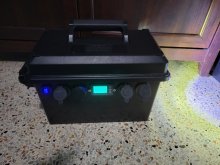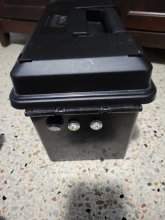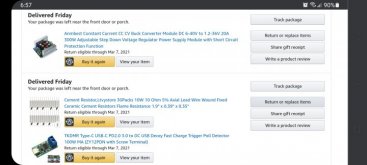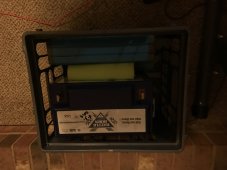Hello! I am new here and am rather illiterate over the whole electricity thing, but I am hoping I can build a portable solar camping station. I do a lot of off grid camping in rather remote places. Right now, I own an Aimtom 300wh power station, with foldable 100w solar panels, but would like a second set up for when the days are overcast. I have studied all the commercial ones, and the price is definitely a factor in wanting to do my own. Am I biting off more than I can chew with this? : P
You are using an out of date browser. It may not display this or other websites correctly.
You should upgrade or use an alternative browser.
You should upgrade or use an alternative browser.
Portable Power Station
- Thread starter jcmac
- Start date
Is this the one you got? It says you need to use their proprietary 60w panels. Have you determined that you can use other 100w panels OK?Hello! I am new here and am rather illiterate over the whole electricity thing, but I am hoping I can build a portable solar camping station. I do a lot of off grid camping in rather remote places. Right now, I own an Aimtom 300wh power station, with foldable 100w solar panels, but would like a second set up for when the days are overcast. I have studied all the commercial ones, and the price is definitely a factor in wanting to do my own. Am I biting off more than I can chew with this? : P
AIMTOM 300-Watt Portable Power Station - 280Wh Battery Powered Generator Alternative with 12V, 24V, AC and USB Outputs - Solar Rechargeable Lithium Backup Power - for Camping Outdoors RV Emergency : Amazon.ca: Patio, Lawn & Garden
Find products from AIMTOM at low prices. Shop online for barbecues, mowers, garden tools, generators, snow blowers and more at Amazon.ca
www.amazon.ca
Positronium
New Member
- Joined
- Feb 4, 2021
- Messages
- 97
What battery chemistry and voltage are you thinking of using? For 12V DIY power stations LiFePO4 chemistry is much easier as with a 4S battery the circuits do not need voltage regulation to ensure 12V to devices. Most commercial power stations use NMC variants because they are cheaper, lighter, and smaller that LiFePO4. NMC is better suited for 24V applications.
Which type of connections do you need? Car plug, USB ports, 5.5mm barrel plugs, Anderson Powerpole, etc...
Which type of connections do you need? Car plug, USB ports, 5.5mm barrel plugs, Anderson Powerpole, etc...
Positronium
New Member
- Joined
- Feb 4, 2021
- Messages
- 97
It is a fun project. Just to get you brainstorming, this is one of earliest projects. The battery is 32 Ah 4s LiFePO4. I don't remember exactly but I think the cells are K2 Energy 26650EV (3.2Ah). The box is MTM 50 caliber ammo box. I charge it via the Anderson Powerpole connectors with a 5A NOCO charger with LiFePO4 setting. There is no solar charge controller or inverter but it has many other things.
From left to right
-Switch for the adjacent
*Car plug port
*USB A bus
-TK-15 coulometer for battery parameters
-2nd Car plug port
-Anderson Powerpole Panel mount
Side
-Switch for adjacent
*LEDs
On rear
-Switch
*inlet fan
*outlet fans
From left to right
-Switch for the adjacent
*Car plug port
*USB A bus
-TK-15 coulometer for battery parameters
-2nd Car plug port
-Anderson Powerpole Panel mount
Side
-Switch for adjacent
*LEDs
On rear
-Switch
*inlet fan
*outlet fans
Attachments
I am making one right now.
LiFePo4 fortune 25ah cells Eight of them in a 2p4s arraignment for a 50ah 12v battery.
Overkill bms
In a Harbor Freight “pelican type” case Apache 2800.
Switch to turn on/off
Anderson Power Pole connections.
cig lighter socket
Voltage meter w/2 USB ports.
12v LED light on case
Will charge through the Anderson connections.
LiFePo4 fortune 25ah cells Eight of them in a 2p4s arraignment for a 50ah 12v battery.
Overkill bms
In a Harbor Freight “pelican type” case Apache 2800.
Switch to turn on/off
Anderson Power Pole connections.
cig lighter socket
Voltage meter w/2 USB ports.
12v LED light on case
Will charge through the Anderson connections.
I have been using RockPals 100W folding solar panels, and it seems to work fine. No problems. I bought my Aimtom about two years ago and I thought I asked them about using compatible panels and that it was OK. Oh to have a good memory...Is this the one you got? It says you need to use their proprietary 60w panels. Have you determined that you can use other 100w panels OK?
AIMTOM 300-Watt Portable Power Station - 280Wh Battery Powered Generator Alternative with 12V, 24V, AC and USB Outputs - Solar Rechargeable Lithium Backup Power - for Camping Outdoors RV Emergency : Amazon.ca: Patio, Lawn & Garden
Find products from AIMTOM at low prices. Shop online for barbecues, mowers, garden tools, generators, snow blowers and more at Amazon.cawww.amazon.ca
Philo DuFresne
New Member
- Joined
- Jan 13, 2021
- Messages
- 27
I have the aimtom 300w gen, and an aimtom 100w folding panel, they are made to work together, i think... they do, anyway. Still, it's not much power, and the new DIY video Will Prowse put up on YouTube is pretty great as far as a doable step up. Good luck!
Thanks for the encouragement! I am coming to realize that my present system is not going to be enough for my portable fridge. : (I have the aimtom 300w gen, and an aimtom 100w folding panel, they are made to work together, i think... they do, anyway. Still, it's not much power, and the new DIY video Will Prowse put up on YouTube is pretty great as far as a doable step up. Good luck!
When you say that you charge via Anderson powerpole using a NOCO charger, does that mean you made an adapter cable? If so, mind explaining that or posting a picture? I'm building one of these and have a NOCO charger. I'm stuck on how to go from the NOCO's alligator clips to a connector on my battery box. Thanks!It is a fun project. Just to get you brainstorming, this is one of earliest projects. The battery is 32 Ah 4s LiFePO4. I don't remember exactly but I think the cells are K2 Energy 26650EV (3.2Ah). The box is MTM 50 caliber ammo box. I charge it via the Anderson Powerpole connectors with a 5A NOCO charger with LiFePO4 setting. There is no solar charge controller or inverter but it has many other things.
From left to right
-Switch for the adjacent
*Car plug port
*USB A bus
-TK-15 coulometer for battery parameters
-2nd Car plug port
-Anderson Powerpole Panel mount
Side
-Switch for adjacent
*LEDs
On rear
-Switch
*inlet fan
*outlet fans
If so, mind explaining that or posting a picture? I'm building one of these and have a NOCO charger. I'm stuck on how to go from the NOCO's alligator clips to a connector on my battery box. Thanks!
Cut the wire, figure out which wire is pos & neg.
Crimp on Anderson Power Pole connections to both sides of the wire you cut - (So you can use the charger with alligator clips in the future).
On Battery Box add a Power Pole connector that connects to battery.
Now you can plug your charger into the battery box and also charge something else with the alligator clips.
You can also connect a load device with Power Pole Connectors and plug that into the same battery connection.
Was the explanation understandable.
It was! Thank you. That makes sense and sounds like the ideal way to keep the original functionality of the charger.Cut the wire, figure out which wire is pos & neg.
Crimp on Anderson Power Pole connections to both sides of the wire you cut - (So you can use the charger with alligator clips in the future).
On Battery Box add a Power Pole connector that connects to battery.
Now you can plug your charger into the battery box and also charge something else with the alligator clips.
You can also connect a load device with Power Pole Connectors and plug that into the same battery connection.
Was the explanation understandable.
Positronium
New Member
- Joined
- Feb 4, 2021
- Messages
- 97
When you say that you charge via Anderson powerpole using a NOCO charger, does that mean you made an adapter cable? If so, mind explaining that or posting a picture? I'm building one of these and have a NOCO charger. I'm stuck on how to go from the NOCO's alligator clips to a connector on my battery box. Thanks!
It is pretty much as Rocketman said. I first verified that the wires were properly color coded. I almost fried one LiFePO4 battery one time because a Chinese charger was improperly color coded, had two black wires with red and black alligator clips switched up. Luckily I checked polarity first with my multimeter.Cut the wire, figure out which wire is pos & neg.
Crimp on Anderson Power Pole connections to both sides of the wire you cut - (So you can use the charger with alligator clips in the future).
On Battery Box add a Power Pole connector that connects to battery.
Now you can plug your charger into the battery box and also charge something else with the alligator clips.
You can also connect a load device with Power Pole Connectors and plug that into the same battery connection.
Was the explanation understandable.
The first thing I said was to hell with the proprietary plug placed the Anderson Powerpole connection where the proprietary plug went and also placed them on the alligator clip if I ever needed to use them. In my case I used 30A Anderson connectors which is way above the 5A the charger is capable of.
Attachments
Does anyone have any cheaper alternatives for chargers that will charge these small boxes? My friend did express that he wants to build one but the higher price of the NOCO chargers turned him off. Surely there has to be some <$10 chargers with the proper spec to charge a small 16ah battery?
Positronium
New Member
- Joined
- Feb 4, 2021
- Messages
- 97
You can try what I did in the picture below. I wanted to charge my battery for one of my projects with USB-C PD at 60W. The components I used in the second screenshot. I have a 100W USB-C PD charger for tablet and phone. I used a USB-C PD trigger board with output set to 20V. I run the trigger board output through a buck converter with max current set to 5A and max voltage set to 13.55V. Make sure to use multimeter when setting these parameters on buck converter. The reason behind setting the voltage to 13.55V is that it is a safe float voltage for 4s LiFePO4. If the max voltage is set to 14.4V and you forget to disconnect your battery it will get damaged. 13.55V will not top-off the battery but it is around 90% charged.
There are cheaper CC-CV buck converters and trigger boards but as I wanted oversize a little bit for heat dissipation. A similar setup with cheaper components can be made with less than $20. If you have a spare laptop charger with voltage >=15V and charging current >=3A, you can cut the tip, strip it, check polarity with multimeter, and plug charger wires to buck converter. This would accomplish the same as what I did for just the price of the buck converter. Make sure the charger voltage >=15V and within the input voltage range of the buck converter you choose. Make sure the charger you use can supply enough current for the charging current you seek for the battery. For 16Ah and small buck converter I wouldn't use a charging current more than 5A.
There are cheaper CC-CV buck converters and trigger boards but as I wanted oversize a little bit for heat dissipation. A similar setup with cheaper components can be made with less than $20. If you have a spare laptop charger with voltage >=15V and charging current >=3A, you can cut the tip, strip it, check polarity with multimeter, and plug charger wires to buck converter. This would accomplish the same as what I did for just the price of the buck converter. Make sure the charger voltage >=15V and within the input voltage range of the buck converter you choose. Make sure the charger you use can supply enough current for the charging current you seek for the battery. For 16Ah and small buck converter I wouldn't use a charging current more than 5A.
Attachments
Last edited:
Hey guys, you can check this portable power station as your backup source.It's highly cost effective.
Jeffjeeptj
New Member
- Joined
- Mar 28, 2020
- Messages
- 53
Do you truly need a full featured Solar camping power station? For me, 110AC has not been necessary, 12V DC is adequate. I built a simple LiFePO4 battery in a battery box with a dc to dc charger on the side. It has no inverter, the SCC is separate and used when it is not raining (seems like the solar panels work better when it is not raining, too). ; ).
The battery box can be plugged into a high capacity connector (Anderson SB50) inside the rear footwell of the Sequoia using the DC to DC charger, the red wire at the top of the box is the “trigger” wire for the charger which plugs into an ignition hot cig lighter, the fridge plugs into the connection at the top of the battery box, and there is an Anderson PP 30 with 10GA wires for stuff like DC to usb charging. There is no shore power charger.
It looks like hair dryer on low power may be necessary this season, so i’m in the trial stages of a 1000W inverter (hair dryer on low) in a milk crate and move the Dc to Dc to the crate. Only real problem is the milk crate will not fit in the footwell, which is solvable.
The battery box can be plugged into a high capacity connector (Anderson SB50) inside the rear footwell of the Sequoia using the DC to DC charger, the red wire at the top of the box is the “trigger” wire for the charger which plugs into an ignition hot cig lighter, the fridge plugs into the connection at the top of the battery box, and there is an Anderson PP 30 with 10GA wires for stuff like DC to usb charging. There is no shore power charger.
It looks like hair dryer on low power may be necessary this season, so i’m in the trial stages of a 1000W inverter (hair dryer on low) in a milk crate and move the Dc to Dc to the crate. Only real problem is the milk crate will not fit in the footwell, which is solvable.
Attachments
Similar threads
- Replies
- 1
- Views
- 378
- Replies
- 15
- Views
- 553
- Replies
- 8
- Views
- 315
- Replies
- 3
- Views
- 264










